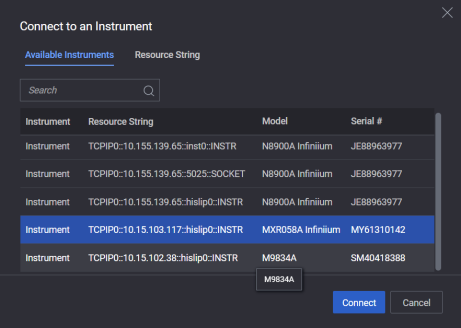Connecting to an Instrument
When you use Interactive IO, the first thing you have to do is connect to an instrument.
There are two ways to connect:
-
Selecting from the list of connected instruments.

-
Manually entering the Resource Name.
Connection Strings (Resource Names)
The Resource String acts as a unique address to locate an instrument on the network. When configuring an instrument's connection details using Connection Expert, you'll see a generated VISA address, which includes all the necessary information to locate the instrument on a specific I/O interface.
A connection string consists of the interface name and number, address, and optionally "INSTR." Here are some examples:
-
GPIB[board]::primary address[::secondary address][::INSTR]
-
ASRL[board]::[INSTR]
-
TCPIP[board]::host address[::LAN device name]::[INSTR]
If you're connecting to a serial instrument, start Connection Expert, ensure the port is recognized, adjust settings as needed, close Connection Expert, and restart Interactive IO.
Other examples of connection strings (Resource Names) include:
-
GPIB0::22
-
TCPIP0::jetscrm3::gpib0,22::INSTR (E5810A LAN/GPIB Gateway)
-
TCPIP::portal6::hpib,10 (E2050 LAN/HP-IB Gateway)
-
USB0::2391::1031::0000000123::0::INSTR
As you can see, USB connection strings can be quite long, but you can simplify this by using Connection Expert to assign aliases to your instruments.
